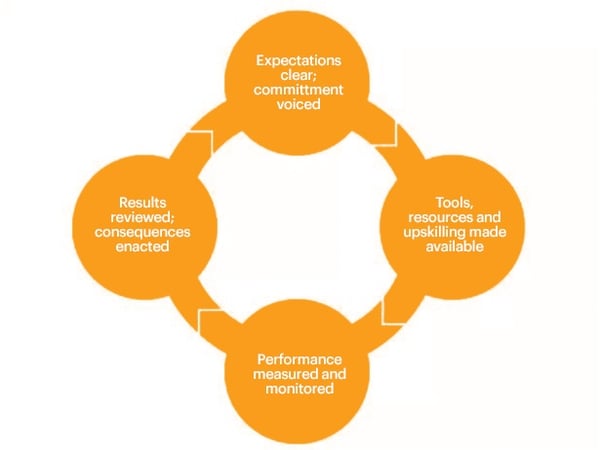3 Ways to Put the ‘Performance’ into Your Performance Culture

This is the sixth and final part of a series explaining how agile strategy-making can get you to where you want to go, faster. Click here to read part one: Why having a business strategy isn’t too ‘fancy-pants’ for your business.
In a past engagement I was invited to restrict my role to providing strategic advice directly to the CEO of a large organization, on an ongoing basis. His plan was to then work with his team to interpret and implement my recommendations. While that was happening, I could carry on making more strategy.
I turned the invitation down.
It wasn’t that I was being proud. Nor was I trying to be difficult. It’s simply that I have never seen strategy-making work effectively in a vacuum. Strategy is useful when it’s contained in a tight feedback loop. In that loop: execution is made visible; meaningful results are monitored and scrutinized; learnings are collected and integrated into strategy-making for the next iteration.
If you haven’t read parts one to five of this blog series (of course I recommend that you do; starting here), you could be forgiven for thinking that sound strategic thinking could occur in the absence of current results and thoughtful analysis of the trends involved. But let me disabuse you of any such illusions right now: it just can’t.
And anyway, beyond issues around soundness of strategy-making, there’s no accountability in the scenario I was invited to take part in. And if I’ve encountered a single issue that perplexes virtually every organization I’ve worked with, it’s accountability. Or more specifically, it’s their ongoing struggle with making accountability stick.
If that’s you too, then let me introduce some stupidly simple management thinking that could revolutionize your workplace and your results.
3 ways to put the performance into your performance culture
1. Meet the Accountability-Trust loop:

It’s designed on the basis that accountability can't exist without trust, which can't exist without accountability. So there's an invisible condition for the loop to function, which – ironically! – is transparency. Expectations must be transparent. Gaps in capability must be transparent. Performance and results must be transparent, and likewise the review process.
Like all good management models, it’s very simple. Yet if you instill it into the heart of your organizational culture you’ll observe a huge change in the performance of individual employees and teams that can quickly translate into a huge competitive advantage.
2. Closely related, read this excellent piece on management-with-accountability.
If you don’t have time then just absorb the crux of it, in ”paraphrased” graphic form:
“Eyes on” is a nice, concise way to encapsulate the transparency that a trust-accountability loop relies on.
3. Grab a copy of The Advantage— like, now!
Truly the only business book I ever recommend and, without a word of a lie, some of the people I’ve recommended it to quote it back to me like they invented it, every time I work with them. I’m good with that, because if you take it on board it really does feel like it’s yours.
Again in the interests of time and efficiency, here are two of its accountability nuggets:
“Silence is disagreement” — if your team isn’t voicing agreement, don’t just assume they agree. Rather, assume that they don’t and, if their agreement is necessary, flush out any issues that require resolution.
“Disagree and commit” – commitment is a fundamental requirement for accountability. There will always situations in which it’s impossible to gain absolute consensus, but these can’t be allowed to derail your progress. In those situations, it’s reasonable and necessary to ask for every team member’s commitment, and for them to apply themselves to a solution as though it was their own idea.
Confused about why I’m banging on about accountability in a post about agile strategy? Genuinely It’s because:
- Strategy fails if it doesn’t take into account the real situation in your business
- Strategy fails if there’s no feedback loop connecting plans, actions and results
- Strategy fails if teams don’t genuinely buy in to – or at least genuinely commit to – its implementation.
But most of all:
- Strategy fails if the people responsible for its implementation aren’t held accountable for the effectiveness of that implementation.

We all know about the best-laid plans of mice and men. The tactics you meticulously planned, when deployed in the real and bloody world of modern commerce, won’t work as brilliantly as you’d hoped.
But since that equally goes for your competitors too, it’s all the more reason to stay agile, follow the feedback loop, and maintain accountability for the effectiveness of your strategy-making and its execution.
This is the final post in the series, so I hope it’s been worthwhile reading. But if you’ve reached this point and still have questions, feel free to get in contact with us!
This blog is written by Dan Thurston, an agile strategy expert.


